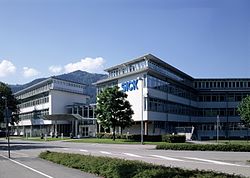This article has multiple issues. Please help improve it or discuss these issues on the talk page . (Learn how and when to remove these messages)
|
 | |
 The headquarters of Sick in Waldkirch | |
| Company type | Aktiengesellschaft |
|---|---|
| Industry | Industrial sensors |
| Founded | 1946; 79 years ago |
| Headquarters | , |
| Revenue | |
Number of employees | 11,804 (2024) |
| Website | www.sick.com |
Sick AG (stylized in all capital letters), based in Waldkirch (Breisgau), Germany, is a global manufacturer of sensors and sensor solutions for industrial applications. The company is active in the areas of factory and logistics. The company employs 11,804 employees worldwide and achieved sales of EUR 2.1 billion in 2024. [1]
Contents
The company is particularly well known for its laser scanners, which are used as sensors in the fields of facility protection (security), ports, and robotics. Five LIDARs produced by the Sick AG were used for short-range detection on Stanley, the autonomous car that won the 2005 DARPA Grand Challenge; they can be seen on the roof of the vehicle. SICK/IBEO LIDARs were also used for obstacle avoidance, mapping, and pedestrian tracking on WAMbot, the autonomous vehicle that came 4th in the MAGIC 2010 competition. SICK AG has ranked among Germany's best employers for several years.